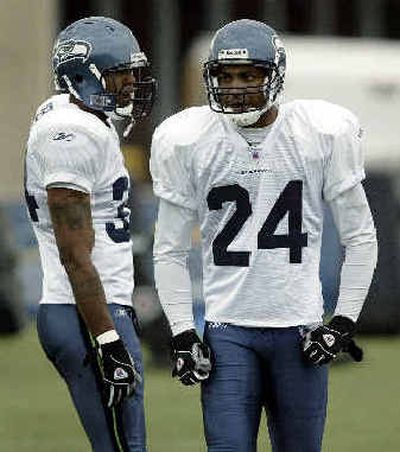Hawks’ secondary stands tall

KIRKLAND — When Ray Rhodes was a defensive backs coach with the San Francisco 49ers in the 1980s, he continually found himself running into a brick wall.
Rhodes, who once overcame long odds to make it as an NFL receiver and defensive back at 5-foot-11 and 185 pounds, would be trying to sell San Francisco defensive coordinator George Seifert on a college defensive back he’d seen. And, inevitably, Rhodes would get cut off.
In his own professorial way, Seifert would ask how tall the player was.
“Every time I’d evaluate a guy that was five-feet-10 or below, he’d look at me like I was crazy,” Rhodes recalled last week.
That’s where the fascination started, and ever since then Rhodes has preferred to build his defenses around big defensive backs.
Since Rhodes became Seattle’s defensive coordinator in January 2003, the Seahawks have added cornerbacks Marcus Trufant (5-foot-11) and Bobby Taylor (6-3), safeties Damien Robinson (6-2), Ken Hamlin (6-2) and Michael Boulware (6-2) and have moved 6-3 strong safety Terreal Bierria into the starting lineup.
Of the eight defensive backs on Seattle’s roster, six are at or above six feet tall. By comparison, the rival St. Louis Rams had no starting defensive backs taller than 5-11.
“There are a lot of advantages to it,” said Rhodes, whose 49er teams drafted big defensive backs like Ronnie Lott and Carlton Williamson. “The key thing with height is, you have reach with it. Bierria is a guy with great reach. Bobby Taylor is a big corner.
“We have some guys now that hopefully we can match up against some of the bigger receivers in the league and get things done. I think it will be to our advantage.”
Head coach Mike Holmgren subscribes to a similar philosophy, although he was dealt an undersized hand when he arrived in Seattle five years ago.
In case he has forgotten just how small Seattle’s secondary was in 1999, Holmgren will be reminded this Sunday when his Seahawks face New Orleans safety Jay Bellamy (5-10) and cornerback Fred Thomas (5-9). Both began their careers in Seattle and eventually played for Holmgren.
Since then, the Seahawks have grown up at the defensive back position – both literally and figuratively.
“It’s a big man’s league,” said Ted Thompson, the Seahawks’ vice president of football operations. “You want big players at every position, and corners are no exception. The bigger, the better, as long as they’re athletic enough to fulfill the requirements of their position.”
In a league that includes receivers like Terrell Owens (6-3, 226 pounds), Randy Moss (6-4, 200) and Keyshawn Johnson (6-4, 212), small defensive backs can be about as useful as a thumb-less quarterback. And the receivers keep getting bigger.
Of the six receivers taken in the first round of the April NFL draft, five of them stand 6-foot-2 or taller.
No wonder the Willie Williamses of the NFL are a dying breed.
“This game has transformed in size and speed, and it’s very essential that you have guys who can go out there and play aggressive bump-and-run against those bigger wide receivers,” said starting cornerback Ken Lucas, who carries a sturdy 205 pounds on his 6-foot frame. “That’s why a lot of teams are looking for bigger corners rather than the short, quicker guys.”
If Seattle’s secondary was a basketball team, Taylor would be the man in the middle. The 6-3 veteran has benefited from unusual height during his first nine NFL seasons – all with Philadelphia.
“Bobby Taylor, at 6-3 or 6-4, is playing against guys his same size,”
Hamlin said. “That’s a good advantage, because you know teams won’t throw up the jump ball.”
Taylor said the key to playing defensive back at his size is to keep up on his footwork. Many taller cornerbacks don’t make it in the NFL because they’ve spent their high school and college careers being able to use their size to overcompensate for a lack of technique.
Because of the ever-growing receivers, the 30-year-old Taylor expects to see taller players developed at cornerback. That wave might be the next to hit the league.
“Hopefully they won’t start rushing into the league until after I retire,” he said.
Whenever the big guys arrive, Rhodes and the Seahawks will probably be interested.